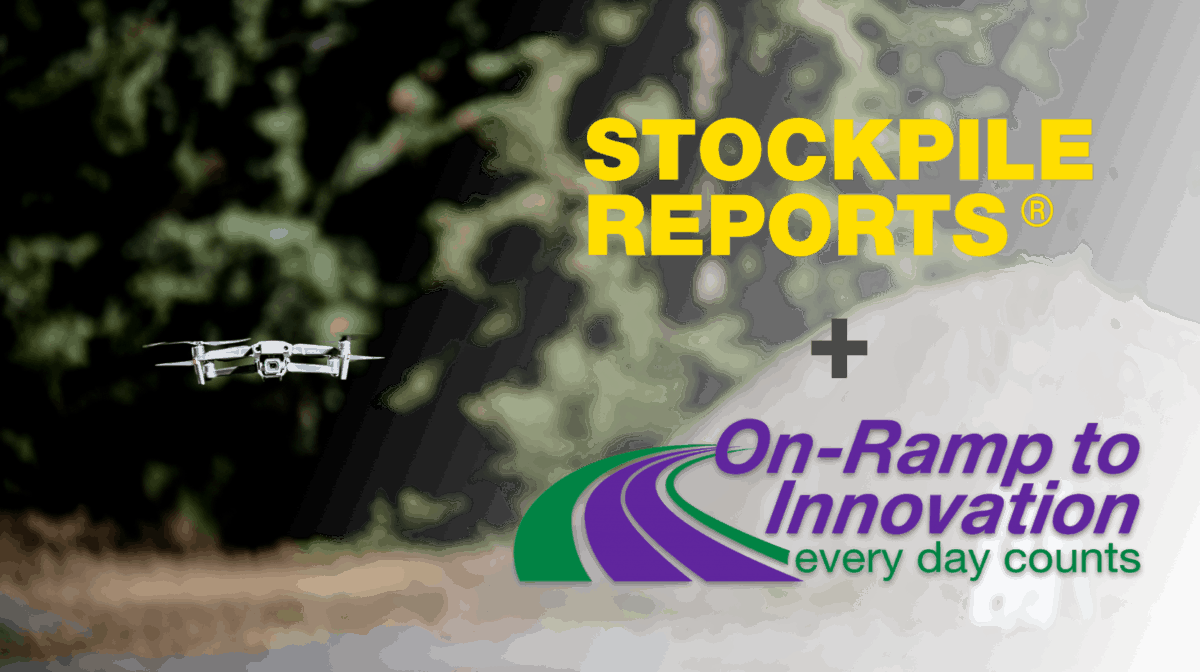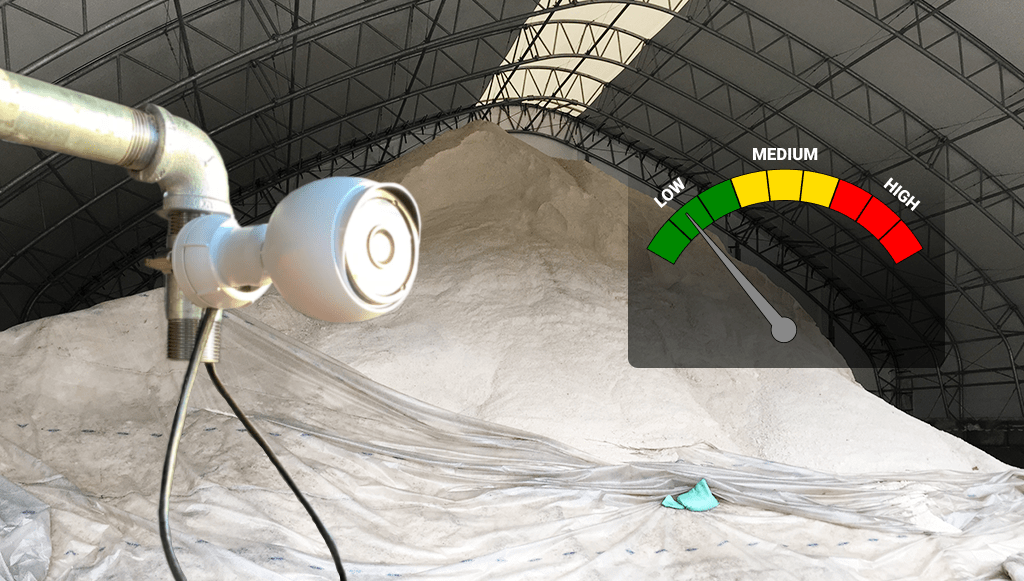August 30, 2019
Why You Should Integrate Stockpile Reports with FHWA’s EDC-5 Program

The Federal Highway Administration (FHWA) is a leader in guiding statewide transportation departments in adopting cutting edge technology. The FHWA started the 2 year long Every Day Counts (EDC) program in 2011 to help states identify proven, innovative technologies and practices that have shortened project delivery timelines and saved state resources. Since 2011, the FHWA has initiated 4 more EDC cycles. The latest cycle, EDC-5, presents 10 under-utilized innovations that the FHWA determined saves time, money and resources in order for state transportation departments to deliver more projects.
Check Out FHWA’s List of Ten EDC-5 Innovations
Stockpile Reports has been working with statewide transportation departments, rock quarries, ready-mix concrete producers, and asphalt companies on two of the latest innovations highlighted in EDC-5: Unmanned Aerial Systems and Weather Response Strategies.
In 2012, Stockpile Reports started stockpile inventory measurement and management using camera-based systems. Initially focused on iPhones as the measurement tool, customers were able to measure stockpile volumetrics by walking around a pile. However, in 2015, Stockpile Reports officially started supporting unmanned aerial systems (drones) to capture images for stockpile measurement.

Today, four statewide transportation departments are using Stockpile Report’s iPhone and drone-based solutions to measure and manage maintenance material stockpiles. Earlier this year, we announced Stockpile Reports for Logistics, where we install low-cost fixed-cameras in structures and on poles to measure in near real-time volumes of critical stockpiles such as road salt and anti-skid material. Hourly measurement data of critical winter maintenance stockpiles gives winter maintenance managers the critical information they need to respond to winter storm events efficiently.
Read: Stockpile Reports for Logistics Generates Inventory Levels From Low-Cost Fixed Cameras
In this article, we are going to go in-depth into how Stockpile Reports is uniquely suited to help statewide transportation departments save time and resources using unmanned aerial systems. We will also show how Stockpile Reports for Logistics can boost winter maintenance response efficiency and save money in the process. Both use cases fit EDC-5 list of 10 innovations.
Streamlining Statewide DOT’s Inventory Management Through UAS
Unmanned Aerial Systems (UAS, or commonly referred to as drones) have been a breakthrough technology in the past couple of years, but surprisingly enough, they have largely been skipped over as a viable tool by statewide government agencies. The capability of capturing image and laser-based data from flying platforms has been overshadowed by the uncertainty of federal laws, regulations, and safety concerns. However, states who have explored and implemented aerial-based intelligence have found numerous opportunities for growth. They have also discovered ways to leverage efficiencies using drones within their operations.
The FHWA highlights UAS as an innovation for visual inspection based applications. Namely, bridge condition inspections and construction progress inspections. Both use cases highlighted by the FHWA are extremely beneficial for promoting safety as well as boosting efficiency in inspection efforts. Inspections are safer and faster by flying a drone around a bridge then suspending a crew by safety equipment to inspect infrastructure.
Read More About FHWA’s EDC-5 Program and UAS
The FHWA did not highlight in their UAS innovation findings the massive opportunity to save time and resources measuring statewide maintenance material resources using drones. Measuring stockpile volumes for maintenance materials management is a perfect use case for implementing UAS programs in statewide transportation departments. Stockpile Reports currently works with 4 statewide departments of transportation (Texas, Oregon, Idaho, and Montana) and 7 county-level governments to measure stockpile inventories. DOTs find that using drones to measure stockpiles eliminates the risk associated with placing workers near busy highways or construction sites to complete the same task on foot. The safety concerns alone are worth the investment.
Learn: Why Idaho Transportation Department Chose Stockpile Reports for Stockpile Inventory Management
Many transportation departments do not consider drones for stockpile measurement due to many piles being placed under cover. However, Stockpile Reports is the perfect fit for transportation departments because of their patented iPhone measurement app. Workers are able to efficiently measure outdoor piles with a drone and measure indoor piles with an iPhone camera. Deliveries of large stockpiles for construction jobs can easily and safely be measured with a drone. Salt piles kept indoors can be measured in minutes by a maintenance worker using the iPhone app. Stockpile measurement in the winter will no longer be a guessing game or tracking bucket counts.
Read: 3 Reasons DOTs Should Measure Stockpiles with an iPhone
All statewide DOTs should be building drone programs to utilize all of the benefits possible of having sensors in places that are impossible or unsafe to reach. Monitoring possible risks of landslides with LiDARs mounted drones, capturing construction progress photos with consumer drones, or inspecting infrastructure with thermal and zoom cameras are all excellent use cases. However, do not skip one of the use cases easiest to implement: stockpile measurement. TxDOT alone saved $2.1 million and 20 FTEs using iPhones and drones to measure stockpiles with Stockpile Reports.
Near Real-Time Salt Pile Monitoring as Part of Your Weather-Responsive Management Strategy
The second innovation that FHWA names in EDC-5 is Weather-Response Management Strategies. The innovative strategies include two parts. The first part is weather-responsive traffic management (WRTM) which improves the effectiveness of traffic operations during adverse road weather conditions. This is mainly achieved through improved communication systems to inform drivers of safe routes during winter storm events. The second part is weather-responsive maintenance management (WRMM) strategies to help reduce costs associated with winter maintenance. WRMM is achieved by improving data systems associated with distributing machinery and materials to the correct locations prior to impending storm events.
Read More About EDC-5 Weather Response Innovation
Stockpile Reports’ for Logistics solves a portion of the WRMM puzzle by generating near real-time salt pile volumes into a centralized portal to best manage costly salt stores before, during, and after storm events. Low-cost fixed cameras installed inside salt sheds continuously monitor salt reserves which provide maintenance managers data they need to ensure they have the correct amount of materials on hand. Stockpile Reports centralizes salt reserve stockpile volumes into a single online viewer, improving resource sharing between maintenance districts with seamless data sharing. Winter maintenance managers can shift salt reserves between geographic areas ahead of a storm and not leave a single location too low on resources improves, improving operational efficiency.

Two of the biggest benefits Stockpile Reports for Logistics brings to WRMM is eliminating the need for Storm Event Inventory Sheets and Truck Logs as well as the ability to Calibrate Your Automated measurement systems and fine tune your salt application rates.
Continuous monitoring and measurement of your salt stockpiles mean that truck logs become obsolete. You will no longer need to track how much is taken out and replaced by a salting truck. The volumes of the reserves are measured on an hourly basis. At the end of a storm event, you will already know what is left in reserves. Countless hours of truck log reconciliation is eliminated from the maintenance workflow.
Having on-demand measurements with iPhones and fixed-cameras also lets you track exactly how much salt each truck applied during their routes. Measuring the salt loaded into a truck and unloaded at the end provides a highly accurate metric for how much salt over a given number of miles. This enables crews to calibrate application rates coming from trucks to ensure road salt is not being over-applied.
Learn: How Stockpile Reports is Revolutionizing Road Salt Management
Maximize EDC-5 Innovations with Stockpile Reports
The FHWA’s Every Day Counts program has proven that adopting underutilized innovations will save transportation departments resources and money in the long run. States willing to invest in new technology will be seen as leaders in innovation and save money and time in the process. Commercial industries are leaning heavily into UAS adoption and have seen massive benefits to their bottom lines. It is time for statewide transportation departments to adopt UAS technology and capture the benefits as well.
The upfront process of building a drone program requires many hardware purchases, certifications, and crew training. Undertaking the technology will take a major effort, however, if your organization decides to adopt drones into day to day operations, ensure that you are maximizing the full benefits. Stockpile Reports is an easy solution to implement to ensure you are maximizing ROI with a drone program. Automated flight applications and sense-and-avoid sensors on drones mean your pilots do not have to be experts at maneuvering the drone to measure stockpile inventory. This makes our solution an easy first step for your UAS program.
DOTs looking to improve winter maintenance management needs to look further beyond the logistics of truck movement. Ensuring your trucks are in the right location prior to a winter storm event is a crucial task. However, ensuring you have the correct amount of maintenance materials in right locations ahead of a storm is just as crucial. Stockpile Reports for Logistics uses fixed-cameras installed in salt sheds which means your maintenance crews do not have to spend time measuring stockpiles. The data will always be captured continuously meaning the data you need will always be at your fingertips.
If you would like to learn more about how Stockpile Reports can work with your EDC-5 innovation strategies, please contact us and we will find the solution that is right for you.
Contact UsStay In the Know
Be the first to know about the latest Stockpile Reports news and features.